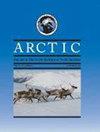Seasonal Sea Ice Conditions Affect Caribou Crossing Areas Around Qikiqtaq, Nunavut: Uqsuqtuurmiut Knowledge Guides Ice Chart Analysis
IF 0.8
4区 地球科学
Q4 ENVIRONMENTAL SCIENCES
引用次数: 0
Abstract
Though polar ecologists consider sea ice primarily as a habitat for marine mammals, caribou use sea ice to complete their reproductive cycles, to access areas with preferred climatic and vegetation conditions, and to avoid predators seasonally and sporadically. Building on previous caribou research in Uqsuqtuuq (Gjoa Haven, Nunavut), we explored the connections between caribou and sea ice phenology in 5 community-identified caribou crossing areas around Qikiqtaq (King William Island). We defined freeze-up and breakup based on Uqsuqtuurmiut (people of Uqsuqtuuq) knowledge of caribou habitat requirements, to orient our analysis to the complex and multifaceted hazards that caribou can encounter while moving through their dynamic and unpredictable sea ice habitat. We investigated the reliability of caribou sea ice habitat surrounding Qikiqtaq, prioritizing key transitional periods with intensified caribou movement. We use regional ice charts produced by the Canadian Ice Service (CIS) and held workshops with Uqsuqtuurmiut to understand how sea ice phenology and caribou mobility have changed over time. The high spatial and temporal variability of sea ice phenology around Qikiqtaq facilitates caribou moving across sea ice should they need to respond to seasonal or unpredictable changes in ecological conditions or anthropogenic disturbance. Therefore, these localized sea ice conditions may increase caribou resiliency to changes or extreme events by providing alternative options for movement across the sea ice. We encourage others to consider the needs of wildlife sea ice users when assessing or providing ice information.季节性海冰条件影响努纳武特奇基克塔克周围Caribou穿越区:Uqsuktuurmiut知识指南冰图分析
尽管极地生态学家认为海冰主要是海洋哺乳动物的栖息地,但驯鹿利用海冰来完成繁殖周期,进入气候和植被条件优越的地区,并季节性地和零星地躲避捕食者。在之前在乌克苏克图克(努纳武特Gjoa Haven)进行的驯鹿研究的基础上,我们在奇基克塔克(威廉王岛)周围的5个社区确定的驯鹿穿越区探索了驯鹿与海冰表型之间的联系。我们根据Uqsuktuurmiut(Uqsuxtuuq人)对驯鹿栖息地需求的了解来定义冻结和分解,以使我们的分析指向驯鹿在其动态和不可预测的海冰栖息地中移动时可能遇到的复杂和多方面的危险。我们调查了奇基克塔克周围驯鹿海冰栖息地的可靠性,优先考虑了驯鹿运动加剧的关键过渡期。我们使用加拿大冰服务局(CIS)制作的区域冰图,并与Uqsuktuurmiut一起举办了研讨会,以了解海冰的酚学和驯鹿的流动性是如何随着时间的推移而变化的。Qikiqtaq周围海冰的高时空变异性有助于驯鹿在需要应对生态条件或人为干扰的季节性或不可预测的变化时穿越海冰。因此,这些局部海冰条件可以通过提供穿越海冰的替代选择来提高驯鹿对变化或极端事件的抵御能力。我们鼓励其他人在评估或提供冰信息时考虑野生动物海冰使用者的需求。
本文章由计算机程序翻译,如有差异,请以英文原文为准。
求助全文
约1分钟内获得全文
求助全文
来源期刊

Arctic
地学-环境科学
CiteScore
2.30
自引率
0.00%
发文量
51
审稿时长
6-12 weeks
期刊介绍:
Arctic is a peer-reviewed, primary research journal that publishes the results of scientific research
from all areas of Arctic scholarship. Original scholarly papers in the physical, social, and biological
sciences, humanities, engineering, and technology are included, as are book reviews,
commentaries, letters to the editor, and profiles of significant people, places, or events of northern
interest
 求助内容:
求助内容: 应助结果提醒方式:
应助结果提醒方式:


